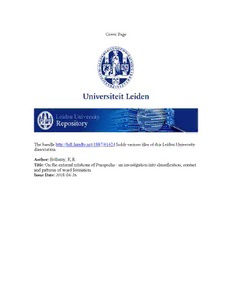
On the external relations of Purepecha. An investigation into classification, contact and patterns of word formation PDF
Preview On the external relations of Purepecha. An investigation into classification, contact and patterns of word formation
Cover Page The handle http://hdl.handle.net/1887/61624 holds various files of this Leiden University dissertation. Author: Bellamy, K.R. Title: On the external relations of Purepecha : an investigation into classification, contact and patterns of word formation Issue Date: 2018-04-26 429208 Kate Bellamy K Kate Bellamy a t e On the external relations of Purepecha On the external relations B e l An investigation into classification, contact and la of Purepecha m patterns of word formation y An investigation into classification, Taking a systematic, multi-method approach, this thesis considers Purepecha in the Latin contact and patterns of word formation American context from the perspectives of genealogy and contact, as well as offering insight into the history of the language through two studies focussing on word formation processes. O The genealogy study re-visits the two most prominent classification proposals for Purepecha n - Greenberg (1987) and Swadesh (1967) - concluding on the basis of a quantitative lexical t comparison using the Oswalt Monte Carlo Shift Test and a more traditional typological h e comparison of affix ordering that no signal of relatedness between Purepecha and any other sampled language can be identified. The two language contact studies address possible e x interaction between Purepecha and other languages at long-distance, regional and local t levels. The lexicon of metallurgy, the most convincing archaeological evidence for interaction e r between South America and West Mexico, does not support this contact scenario although n the lack of observable loanwords in this domain may reflect the largely non-verbal nature of a technology transmission. A lexical comparison of over 1600 terms shows that at the regional l r and local levels, Purepecha also displays very few borrowings from the prehispanic period. e This paucity of borrowings is reversed in the modern period, with Spanish exerting a heavy l a influence on all aspects of the language. The shift in borrowing pattern is explained by the t gargantuan socio-political change experienced by Purepecha speakers since the imposition i o of Spanish, with language acting as a mirror for social change. The two studies on word n formation focus on the varying semantic transparency of the roots and suffixes that comprise s the language, with a specific emphasis on olfactory language, and introduce the notion that o f roots may be precategorial in nature. This language-internal work provides greater context P for future investigation into processes of historical development and possible comparative u efforts. r e p e c h a ISBN 978-94-6093-282-3 On the external relations of Purepecha An investigation into classification, contact and patterns of word formation Published by LOT Telephone: +31 30 253 6111 Trans 10 3512 JK Utrecht Email: [email protected] The Netherlands http://www.lotschool.nl Cover illustration: Kate Bellamy. ISBN: 978-94-6093-282-3 NUR 616 Copyright © 2018: Kate Bellamy. All rights reserved. On the external relations of Purepecha An investigation into classification, contact and patterns of word formation PROEFSCHRIFT te verkrijging van de graad van Doctor aan de Universiteit Leiden, op gezag van de Rector Magnificus prof. mr. C.J.J.M. Stolker, volgens het besluit van College voor Promoties te verdedigen op donderdag 26 april 2018 klokke 10:00 uur door Kate Rosalind Bellamy geboren te Sheffield in 1981 Promotor Prof. dr. W. F. H. Adelaar Co-promotor Dr. E. B. Carlin Promotiecomissie Dr. A. Capistrán Garza (Universidad Autónoma Metropolitana-Iztapalapa) Dr. C. Chamoreau (SeDyL/CNRS) Prof. dr. M. A. F. Klamer Prof. dr. M. P. G. M. Mous Prof. dr. P. C. Muysken (Radboud University Nijmegen) The research for this thesis was carried out as part of the project “The Linguistic Past of Mesoamerica and the Andes (Mesandlin(g)k)”, financed by the European Research Council (ERC), under the European Union’s Seventh Framework Programme (FP7/2007-2013) / ERC Grant Agreement No. 295918. For my parents, all three of them i Table of Contents Acknowledgements................................................................................................ v Abbreviations ..................................................................................................... viii List of Figures ...................................................................................................... xi List of Tables ....................................................................................................... xii 1. INTRODUCTION ......................................................................................... 1 1.1. Introductory remarks, or trying to solve an unsolvable puzzle ................ 1 1.2. Introduction to Purepecha ...................................................................... 3 1.3. History of the Purepecha People ............................................................ 7 1.3.1. Early cultures in Michoacán ........................................................ 7 1.3.2. The Tarascan State .................................................................... 10 1.3.3. The Colonial Period .................................................................. 13 1.4. Previous research on the language ....................................................... 15 1.4.1. Other written sources ................................................................ 16 1.5. Language structure .............................................................................. 18 1.5.1. Phonology ................................................................................ 19 1.5.2. Morphology .............................................................................. 22 1.5.3 Syntax ...................................................................................... 34 1.6. Language Vitality and Revitalisation Efforts ........................................ 37 1.7. Data and field site ............................................................................... 41 1.8. Research questions .............................................................................. 42 1.9. Thesis outline ...................................................................................... 43 2. CLASSIFICATION ATTEMPTS ................................................................ 49 Abstract ............................................................................................................... 49 2.1. Introduction ........................................................................................ 50 2.2. Previous classification attempts ........................................................... 52 2.2.1. Swadesh’s proposals ................................................................. 54 2.2.2. Greenberg’s classification ......................................................... 59
